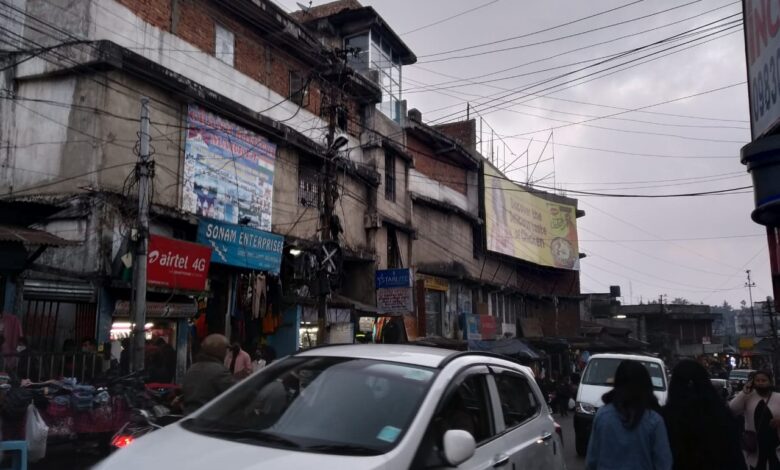Too hot to handle
Uncomfortable summer in Shillong this time is the effect of urban heat island phenomenon

This year, Shillong, the quaint hill town that takes pride in its salubrious weather and cool summers, has disappointed not only old residents but also visitors. The days have remained asphyxiating owing to soaring temperature and high humidity. All one could hear walking on the road in the past few days was, “It’s too hot by Shillong standard.”
According to the India Meteorological Department (IMD), temperature has remained above normal as compared to the past 30 years. While the average temperature of Shillong should remain not more than 23°C (maximum) and 17°C (minimum), the ranges varied between 27-28°C and 17-18°C. In fact, on July 15, the maximum temperature shot up to 28.5°C and the minimum was 19.5°C. Humidity was 80%.
“A maximum of 27-28°C has become common in Shillong when there is no rainfall,” said Rakesh Kumar, a scientist at IMD, Upper Shillong.
When pointed out that even after rain, many citizens were complaining of heat or discomfort, Kumar said it was the fallout of a condition called urban heat island.
Urban heat island, or UHI, is a condition when an urban pocket is significantly warmer than its surrounding areas. Though this phenomenon was first recorded in 1810, it is becoming common in many cities thanks to fast concretisation and population and vehicular boom. Shillong, an expanding urban pocket in Meghalaya, too has witnessed unplanned concretisation and increase in the number of vehicles on road.
Situated at an average altitude of 1,496 m above sea level, Shillong has never experienced temperatures beyond 30°C, except in April 1973 when the temperature was 30.2°C. However, the recent years have shown a trend of high temperatures, both maximum and minimum. According to a study by USAID and UNDP on Meghalaya, it is expected that the number of hot days and warmer nights will increase with the projected annual mean warming of about 4.99°C by the end of this century. The study also shows significant changes in the number of hotter days over the hill town during the monsoon season also, particularly during the mid-century or beyond. In the 2020s, the number of hotter days in monsoon will increase five times and that of warmer nights by more than three times.
The rise in urban temperatures result from rampant clearing of greenery and increase in concrete and impermeable surfaces. The pollution from machines, including air-conditioning machines, also add to the heat. The asphalt of roads and concrete of buildings absorb more heat. The daytime heat is usually dissipated at night but the rise in pollution level becomes a hindrance. Also, loss of greenery restricts surface cooling through evapotranspiration — a combination of evaporation and transpiration.
“We see concrete all around us in Shillong. We have to rethink on this. There should be more greenery around,” said Kumar of IMD.
The forest cover in and around Shillong and in other parts of the state has dwindled significantly. Fruit gardens attached to Assam-type houses have become a rare sight in the city as old houses have given way to apartment buildings. The USAID-UNDP study shows increase in mean temperatures in Shillong by 1.17°C by 2020s, 2.97°C by 2050s and 4.99°C by 2080s.
According to experts, the UHI phenomenon has various impacts on the lives of people of the region. Studies have shown that UHI can alter rainfall pattern and affect vegetation and plantation periods. But the worst effect of UHI can be on the health of residents. Unprecedented heat may lead to various ailments, exhaustion and in extreme cases heat stroke.
UHI phenomenon also affects water bodies and aquatic life. High surface temperatures can increase initial rainwater temperature. This is discharged into water bodies increasing the water temperature that affects aquatic life
Many old residents whom Sunday Monitor spoke to said Shillong summers would be really cool even less than three decades back and one had to wear light woollen to feel comfortable. Though things started changing years back with climate change and global heat effect, the weather would still be clement a few years back. It is this weather that attracts hundreds of tourists from across the country, especially from places where summer is extreme, to Shillong. But with changing weather condition, it seems that the city is losing its charm.
“I have heard about Shillong and its weather so much. But it is quite disappointing when I arrived here. Munnar (a hill station in Kerala) is cooler than Shillong,” said Regi K, a tourist from Kerala who visited the hills in the beginning of this month.

Regi observed that if this trend continues in Shillong, then it will lose tourists to other cooler places. The impact of weather on tourism will lead a major alteration in the local economy that majorly depends on tourism.
Many residents would regularly use fans in the last few weeks. Even offices in the Secretariat building were seen using fans regularly. “Fans, AC machines were alien to us once upon a time,” said an elderly employee of the Secretariat.
BP Katakey, former judge of the Gauhati High Court who often visits Shillong for coal-related cases, also agreed that it was the first time that he was experiencing such weather condition. There was a table fan running in his room.
In a situation like this, steps can be taken to mitigate the deterioration in weather conditions. Use of light-coloured concrete and white roofs helps in reduction of heat absorption by at least 50%.
Green roofing is another way of keeping the heat away. Plantation on rooftop is a wonderful way of insulation. Also, the plants will help freshen the air around by absorbing carbon-dioxide. This can be complemented by planting more trees in urban pockets.
But most importantly, the authorities concerned need to have a proper plan in place and the will to implement the plan. Certain restrictions and regulations in constructing buildings and use of vehicles have to be strictly implemented. Citizens should be made aware of UHI and its effects and how it can be reduced. They should also be encouraged to adopt green measures at home and outside.
Shillong has already lost a part of its charm with rapid urbanisation. The pristine beauty has been replaced by the cacophony of cars and buildings. Now that its impact is being felt on the weather, it is time to make crucial changes in the urban planning and regulations.
~ Team Sunday Monitor
Photos by MM




